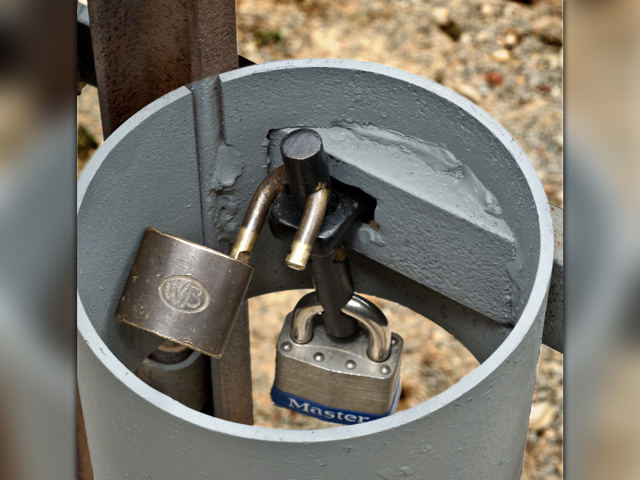Lock Your Gate With This Simple Project
Make it Extremely Difficult to Break Through Your Gate
We once came across a gate latch built to keep thieves from cutting padlocks. No security measure is 100% effective in preventing unlawful access to your farm (the wire fence on both sides of this gate can be cut). But if you make access difficult, thieves are more likely to move on to less secure farms.
This project was made from scrap in a shop outfitted with a welder and a decent lineup of metal working tools.
Security is a special issue on this farm.
The drive from the gate to the home and outbuildings is a hilly half-mile. The buildings are not visible from the road, so thieves getting into those buildings aren't visible from the road either.
P[L1] D[0x0] M[300x250] OOP[F] ADUNIT[] T[]
The pin holding the gate closed can be removed when either lock is opened. Here, the top lock gives the power company access to equipment at the back of the farm. The bottom lock gives the owner access to his property. The pin holds the locks. Holes cut to the size of the shackles are drilled into each end of it.
This lock features a protective cylinder. It is a key piece made from a scrap piece of steel pipe. It serves an important purpose -- it keeps thieves from cutting either one of the locks with something like a bolt cutter. Make sure the cylinder is long enough to prevent thieves from using bolt cutters to break the locks.
The cylinder was split lengthwise to create a strong contact point between the pipe and a vertical piece of the gate frame. A slot was removed from the back of the cylinder to create a second welding point where the cylinder and one of the gate's horizontal members are joined.
Note the piece of flat bar steel protruding through the back of the cylinder (the piece through which the round bar is inserted). A hole is drilled through this piece to accept the pin.
This piece of flat bar is welded perpendicular to a second length of flat bar, then welded to the other side of the gate, opposite the side holding the cylinder. When the gate is closed, the small piece of flat bar slides through the back of the cylinder, as shown. (https://www.dtn.com/…)
The pin and two locks keep it locked.
If you have gate latch ideas, send photos and an explanation to me at the following contact information.
Dan Miller can be reached at dan.miller@dtn.com
Follow him on Twitter @DMillerPF
(c) Copyright 2021 DTN, LLC. All rights reserved.




